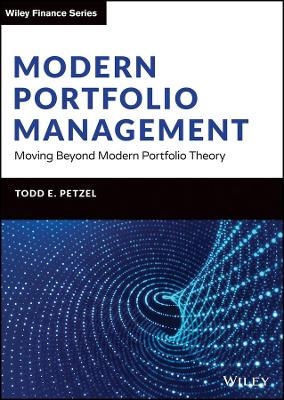
Modern Portfolio Management
John Wiley & Sons Inc (Verlag)
978-1-119-81850-2 (ISBN)
In Modern Portfolio Management: Moving Beyond Modern Portfolio Theory, investment executive and advisor Dr. Todd E. Petzel delivers a grounded and insightful exploration of developments in finance since the advent of Modern Portfolio Theory. You’ll find the tools and concepts you need to evaluate new products and portfolios and identify practical issues in areas like operations, decision-making, and regulation.
In this book, you’ll also:
Discover why Modern Portfolio Theory is at odds with developments in the field of Behavioral Finance
Examine the never-ending argument between passive and active management and learn to set long-term goals and objectives
Find investor perspectives on perennial issues like corporate governance, manager turnover, fraud risks, and ESG investing
Perfect for institutional and individual investors, investment committee members, and fiduciaries responsible for portfolio construction and oversight, Modern Portfolio Management is also a must-read for fund and portfolio managers who seek to better understand their investors.
Todd E. Petzel, PhD, is Chief Economist and Co-Chief Investment Officer of Offit Capital, an independent Registered Investment Advisor serving multi-generational wealthy families and not-for-profit organizations. He was previously Chief Investment Officer at Azimuth Trust and Commonfund. He has taught at Macalester College, Stanford University, and the University of Chicago.
Preface (to come)
1 Introduction
1.1 Why another book on wealth management?
1.2 How has thinking evolved?
1.3 How did “accepted wisdom” let investors down in 2007-2009?
1.4 Make sure the focus of investing portfolios is consistent with the goals of the individual or institution.
SECTION A The Foundation of a Modern Portfolio
2 Setting Objectives
2.1 What are the goals of the investment process?
2.2 Sleep-well-at-night money
2.3 Long-term growth portfolios
2.3.1 The power of compound interest
2.3.2 More risk should mean more return
2.3.3 Losing 100% is “game over”
2.4 Beta – the power of the markets to grow
2.5 Stocks versus bonds as a source of beta – what is the beta of hedge funds?
2.6 Liquidity and access to the credit markets
2.7 Not-for-profits and spending rules
3 The Pillars of Portfolio Theory and their Limitations
3.1 Risk premiums across assets
3.2 The “Free Lunch” of diversification
3.3 Owning the “market” is the most risk efficient portfolio
3.4 The Efficient Market Hypothesis in its many forms; rational expectations
3.5 Modigliani-Miller
3.6 Riskless/Costless Market Arbitrage Pricing
3.7 Advances in Behavioral Finance
4 Building a Modern Portfolio in the Real World; defining your strategy
4.1 The Sleep-Well-at-Night portfolio
4.1.1 Defining how much is enough.
4.1.2 How to preserve wealth and maybe make a little bit along the way
4.1.3 The temptation to reach for yield
4.2 The Basics of the Growth Portfolio
4.2.1 Bonds
4.2.2 Stocks
4.2.3 Alternative Investments
4.2.4 Real Assets
4.2.5 Further variation across the investment landscape – currencies, credit, etc.
4.3 The Fundamental Liquidity Question
Why liquidity matters: your situation changes; the market changes; you simply change your mind; the credit market is not always there when you want it. Giving up liquidity in PE partnerships and hedge funds must be done in terms of alternative opportunities.
4.4 Establishing a portfolio mix and a strategy objective
4.4.1 Determining the goals for return and risk
4.4.2 Broad assumptions about the risk and return of investment options
4.4.3 The fallacy of relying on Optimizers
4.4.4 The fallacy of relying on Simulators
4.4.5 Establishing the Target Growth Portfolio
SECTION B Building the Modern Portfolio
5 Executing the Plan: The Devil is in the Details
5.1 How Much Diversification is Right?
5.1.1 Questioning the Efficient Markets Hypothesis? Do you have special information or skills?
5.1.2 Can you “own the market?” Do you want to given the tools available?
5.1.3 Real Diversification versus owning a bunch of different names
5.1.4 Real Diversification versus owning offsetting (and expensive) trades
5.2 Active managers versus the Index
5.2.1 What is alpha and how can you identify its presence? Sources of alpha
5.2.1.1 Better information
5.2.1.2 Better processing of information
5.2.1.3 More Efficient Execution
5.2.2 Beta and the reality of costs
5.2.3 Bucketing strategies and managers into narrow categories. What is achieved and at what cost?
5.2.4 Passive investing is great IF you want to own the index at that point in time.
5.2.5 Smart Beta – a quasi-active strategy
5.2.6 Active managers can avoid major pitfalls if they are not benchmark constrained.
5.3 Luck versus Skill among active managers
5.3.1 Evaluating managers, against benchmarks, against each other
5.3.2 Classic performance measures and their limitations
5.3.2.1 Compounded returns
5.3.2.2 Standard Deviation
5.3.2.3 Beta
5.3.2.4 Correlation
5.3.2.5 Autocorrelation
5.3.2.6 Sharpe
5.3.2.7 Information Ratio
5.3.2.8 Sortino
5.3.2.9 Omega Ratio
5.3.2.10 Final Comment on the Section
5.3.3 IRR Calculations and Multiples of Capital Returned
5.3.4 Peer groupings
5.3.5 Shaping your own expectation for managers and their role in the portfolio
5.4 Portfolio Construction and Market Trading Realities: High Frequency Trading,
5.5 Manager Due Diligence and Selection
5.5.1 Understanding the investment thesis
5.5.2 Determining the sources of returns and risks
5.5.3 Alpha versus beta, factor decomposition
5.5.4 Do the returns justify the risk?
5.5.5 Getting to know the team
5.5.6 What is the business model of the manager? Are interests even remotely aligned?
5.5.7 Reporting: Results, attribution, risk and position transparency
5.5.8 Operational due diligence
5.5.8.1 trading and trade allocation
5.5.8.2 brokerage relationships and soft dollars
5.5.8.3 ISDA relationships and OTC derivatives
5.5.8.4 custody
5.5.8.5 cash movement
5.5.8.6 pricing of securities and the calculation of the NAV
5.5.8.7 audits – historical financials for firm and funds
5.5.8.8 legal and regulatory
5.5.8.8.1 PPM
5.5.8.8.2 LP Agreement
5.5.8.8.3 ADV II
5.5.8.8.4 Articles of Incorporation
5.5.8.8.5 Subscription Document
5.5.8.9 anti-money laundering
5.5.8.10 internal compliance
5.5.8.11 technology
5.5.8.12 cybersecurity
5.5.8.13 disaster recovery
5.5.9 Background checks: public and private sources
5.5.10 Character and confidence: At the end of the day, do you want to associate with the manager and firm under consideration? Are you completely comfortable trusting them?
5.6 Ongoing Manager Evaluation
5.6.1 Evaluating returns on a regular basis. Positive and negative “outliers.”
5.6.2 Is the manager beating benchmarks? Peers? Your expectations? Is it luck, skill or excess risk taking?
5.6.3 Deal breakers – time to terminate
5.6.3.1 prolonged deviation from expected return performance. Is the process broken?
5.6.3.2 change in investment/risk profile from what was advertised and agreed to
5.6.3.3 loss of key people
5.6.3.4 radical departure from expected/agreed upon client relationships (liquidity provisions, fees, etc.)
5.6.3.5 questionable legal issues
5.7 The Issue of Fraud
5.7.1 Unfortunately, no amount of due diligence will ever eliminate the chance to be victimized by a fraud.
5.7.2 The goal is to have as many safeguards in place as possible so that if fraud occurs, it is detected early when its impact is small.
5.7.3 Investors are not compensated with higher returns by assuming fraud risk. The only safety precaution is through diversification.
5.8 Funds of Funds versus Direct Investment
5.8.1 Advantages:
5.8.1.1 Seasoned judgment of FoF PM
5.8.1.2 Portfolio diversification in a single product
5.8.1.3 Access to resources to do extensive due diligence and portfolio evaluation
5.8.1.4 Consolidated reporting
5.8.1.5 Possibly improved access to managers
5.8.2 Negatives:
5.8.2.1 Fees
5.8.2.2 Perhaps less than ideal portfolio mix.
5.8.2.3 Due diligence does not go away, it just changes focus
5.8.2.4 A Cautionary Tale
5.9 Rebalancing
5.9.1 Across asset classes
5.9.2 Among managers
5.10 Investment Advisers: Getting help when you need it
5.10.1 Different advisory models:
5.10.1.1 Brokerage/product driven advisers
5.10.1.2 Institutional consultants
5.10.1.3 Special case of the Outsourced CIO
5.10.1.4 Independent advisers
5.10.1.5 Robo advisers
5.10.2 The question of discretion
5.10.3 Deciding the best option
5.10.3.1 Alignment of emotions and objectives
5.10.3.2 Costs once again
5.10.3.3 Evaluating performance
6 Tactics for Enhancing Yield
6.1 Market Timing
6.2 Volatility, The Ignored Dimension
6.2.1 Covered calls
6.2.2 Fully collateralized short puts
6.3 Tax loss harvesting
6.4 More Challenged strategies
6.4.1 Extending durations in low interest rate environments
6.4.2 Substituting credit risk for bond allocations
6.4.3 “Insured” portfolios
6.4.4 Portable alpha
6.4.5 Leveraging small alphas to reach acceptable returns
6.4.6 Writing uncovered options to sell time
6.4.7 Blindly buying out-of-the-money options to capture tail events
7 Black Swan Portfolio Positions
7.1 Tail Risk in an Overall Portfolio
7.2 Protective Puts
7.3 CDS
7.4 Other Macro Tail Bets
7.5 The Value of Insurance comes from the Impact on Lifestyle when you don’t have it
8 Market Bubbles and Crashes
SECTION C The Building Blocks for a Modern Portfolio
9 Traditional Portfolio Investments
9.1 Cash
9.2 Fixed Income
9.2.1 Forms of Fixed Income Instruments
9.2.2 Duration and credit risks; bond pricing, convexity and spreads
9.2.3 Sovereign Debt
9.2.4 Agency Debt
9.2.5 Municipal Debt
9.2.6 Corporate Debt
9.2.7 Bank Loans
9.2.8 Mortgages
9.2.9 Direct Loans
9.2.10 Cat Bonds
9.2.11 Mutual Funds
9.2.12 ETFs and ETNs
9.3 Credit
9.4 The Curious Case of Negative interest Rates
9.5 Currencies
9.6 Equities
9.6.1 Individual equities
9.6.2 Preferred stock
9.6.3 Convertible bonds
9.6.4 Accessing the Equity Market
9.6.4.1 Mutual funds, open and closed end (discussion of tax efficiency)
9.6.4.2 ETFs and ETN’s
9.6.4.3 Completion funds
9.7 Hedge Funds
9.7.1 Long/short equity oriented
9.7.2 130/30 funds
9.7.3 Convertible Arb and other Cap Structure funds
9.7.4 Event oriented hedge funds
9.7.5 Credit funds
9.7.6 Macro
9.7.7 Multi-strategy
9.7.8 Commodity Trading Advisers
9.7.9 Quantitative Trading Strategies
9.7.10 Insurance and Litigation Funds
9.7.11 Risk Parity Funds
9.7.12 Volatility Funds
9.7.13 Replication Funds
9.7.14 Hedge mutual funds and liquid alternatives
9.8 Private Equity Partnerships
9.8.1 Venture Capital
9.8.2 Growth Equity
9.8.3 Buy-out
9.8.4 Credit-Equity Hybrid Funds
9.8.5 Secondary Funds
9.8.6 Co-investment Funds
9.9 Real Estate
9.9.1 Direct ownership of property; residential and commercial
9.9.2 Real estate partnerships
9.9.3 Real Estate Investment Trusts (REITs)
9.10 Other Real Assets/ Commodities
9.10.1 Direct ownership of commodities (usually only precious metals, jewels)
9.10.2 Commodity based businesses – metals, energy, farm land, timber.
9.10.3 Synthetic ownership of commodities and commodity index funds
9.10.4 Esoteric Real Assets; Water Rights
9.11 Collectables
9.12 The Question of Currencies from a Global Portfolio Perspective once again
9.13 Cryptocurrencies
10 Derivatives
10.1 Futures
10.1.1 Original and Variation Margins
10.1.2 The Price Basis
10.1.3 TheDealer Community
10.2 Exchange Traded Options
10.2.1 Basics of Calls
10.2.2 Simple Call Strategies
10.2.2.1 Long at-the-money Calls
10.2.2.2 Long out-of-the-money Calls
10.2.2.3 Simple Short Calls
10.2.2.4 Simple Call Spreads
10.2.2.5 Call Calendar Spreads
10.2.3 Basics of Puts
10.2.3.1 Put Spreads
10.2.4 Combinations of Calls and Puts
10.2.4.1 Straddles and Strangles
10.3 Swaps
10.3.1 Interest rate hedging
10.3.2 Portable alpha
10.4 Swaptions
10.5 Credit Default Swaps
11 Investment structures and packages
11.1 Asset Backed Securities
11.2 CDO’s and CLO’s
11.3 Insurance wrappers
11.4 Annuities
11.5 Retail Structured Products
SECTION D Governance, Regulation, and a Look into the Future
12 Investment Decision Making and Governance
12.1 The family
12.2 Not-for-profit boards and committees
12.3 Pension plans
12.4 Corporate Investments
12.5 Socially Responsible Investing
13 Regulation of Investment Activity
13.1 Capital Raising
13.2 Secondary Markets
13.3 Investment Companies
13.4 Investment Advisers
13.5 Summary
14 Looking ahead
15 10 Lessons
Abbreviations
Glossary
Index
| Erscheinungsdatum | 12.11.2021 |
|---|---|
| Verlagsort | New York |
| Sprache | englisch |
| Maße | 183 x 259 mm |
| Gewicht | 1474 g |
| Themenwelt | Wirtschaft ► Betriebswirtschaft / Management ► Finanzierung |
| ISBN-10 | 1-119-81850-8 / 1119818508 |
| ISBN-13 | 978-1-119-81850-2 / 9781119818502 |
| Zustand | Neuware |
| Haben Sie eine Frage zum Produkt? |
aus dem Bereich


